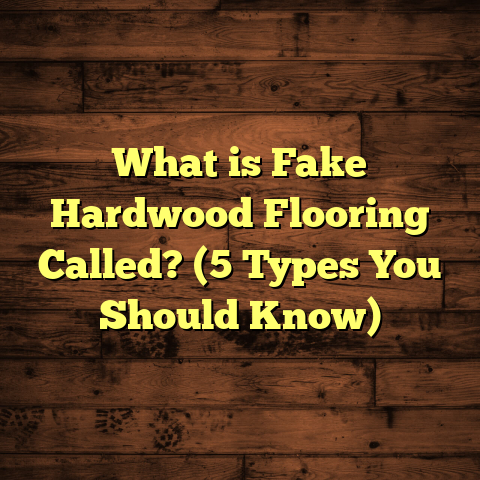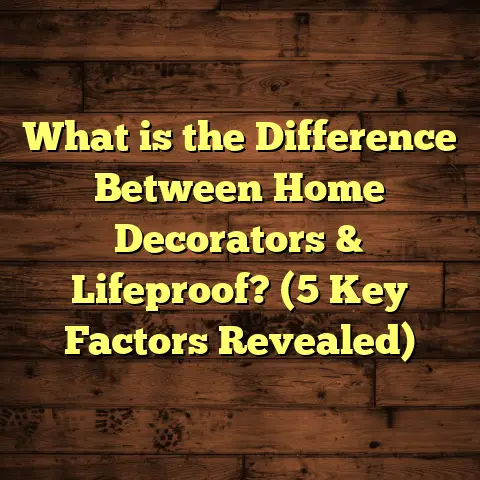What is Etching Garage Floor? (5 Steps to a Smooth Finish)
You hear a lot of chatter about prepping a garage floor before painting or coating — sweeping, mopping, maybe a quick wipe down. But what most people miss, and what I didn’t fully appreciate at first, is the importance of etching the garage floor. You might think cleaning is enough, but that’s only half the battle. Without etching, your coatings won’t stick well; they’ll peel or flake off before you know it.
I remember my first few garage projects when I skipped etching because I thought it was just an extra hassle. Those floors didn’t last long at all. It was frustrating and expensive to redo them. Once I learned the science behind etching and added it as a standard step, the difference was night and day — floors held up for years with minimal wear.
Let me take you through everything I’ve learned about etching garage floors — what it is, why it matters, how to do it right, and some tips to avoid common mistakes. I’ll even share stories from my own experience and data from studies to back up why this step makes a huge impact.
What Is Etching a Garage Floor?
Etching a garage floor means treating the concrete surface with an acidic solution that roughens it up on a microscopic level. Concrete floors are naturally smooth after curing because of a thin layer called “laitance,” which is made of fine particles and cement that create a sealed surface.
This sealed surface is great for durability but terrible for paint or epoxy adhesion. Etching breaks down this smooth layer, opening up tiny pores and creating a rough texture. This “tooth” allows coatings to grab onto the floor better.
Think of it like sanding wood before painting. If you paint bare wood without sanding, the finish might peel or chip quickly. The same idea applies to concrete — etching is your sanding step.
The Science Behind Etching
When you apply an acidic etching solution (like muriatic acid), it reacts chemically with calcium compounds on the concrete’s surface. This reaction dissolves the top layer slowly, removing laitance and exposing the aggregate beneath.
This process creates micro-roughness and increases surface area for coatings to adhere mechanically rather than just sticking superficially.
What Happens Without Etching?
Without etching, coatings have to rely on adhesion to a smooth, sealed surface. This bond is weak and often fails under stress like temperature changes, moisture intrusion, or heavy traffic. The result? Peeling, bubbling, and flaking coatings that ruin the look and protection of your floor.
In fact, studies show that coatings applied over unetched concrete lose adhesion strength by up to 50% compared to those on etched surfaces. That’s why skipping etching can cost you a lot more in maintenance and repairs over time.
Why Etching Is Often Overlooked (and Why That’s a Mistake)
I’ve talked with many homeowners and even some contractors who don’t regularly etch before coating. They assume cleaning alone is enough or find etching intimidating because it involves acids.
But here’s the thing: the extra effort upfront pays off massively in durability and appearance.
My Personal Experience
Early in my flooring career, I worked on several projects where the client insisted on skipping etching — either due to cost concerns or fear of handling chemicals. The floors looked fine initially but started peeling within months.
One project was a medium-sized garage in a humid climate. The owner wanted quick results and declined etching. Within six months, large patches of paint peeled off, exposing bare concrete underneath.
Seeing that failure firsthand convinced me never to skip etching again.
Why People Skip Etching
- Fear of chemicals: Muriatic acid sounds scary (and it should be handled carefully).
- Time constraints: Etching takes time — cleaning, applying acid, rinsing thoroughly, drying.
- Cost concerns: Some think it adds unnecessary expense.
- Lack of knowledge: Many simply don’t know why it’s important.
I get all these concerns because I’ve been there. But consider this: investing time and care in etching prevents costly redo jobs later.
Step 1: Clean Your Garage Floor Thoroughly
Before any etching happens, your floor needs to be spotless. Dirt, grease, oil stains, or even dust can interfere with etching and coating adhesion.
I always start by scrubbing the floor with a heavy-duty degreaser. Garage floors are notorious for oil spots from cars or lawnmowers. If you don’t remove these, your acid might not react properly with the concrete underneath.
How I Clean My Garage Floors
- Sweep all loose debris.
- Apply degreaser generously on oil stains.
- Scrub with a stiff-bristled brush or use a floor scrubber machine.
- Rinse thoroughly with water.
- Let dry or blot excess moisture with a wet vacuum.
I’ve seen floors where cleaning was skipped or done poorly — coatings failed quickly despite etching afterward because contaminants were still present.
Step 2: Select the Right Etching Solution
Muriatic acid is the most common chemical used for etching concrete. It’s strong and effective but requires careful handling because it’s corrosive and produces fumes.
Alternatively, there are acid-free concrete etchers made from safer chemicals like sodium bicarbonate or proprietary blends. These are less hazardous but usually take longer to work.
My Take on Etching Solutions
For most residential garages, muriatic acid works best if you’re comfortable using it safely. It typically takes 10–15 minutes to react with concrete and creates excellent surface texture.
For clients sensitive to fumes or concerned about safety (like indoor spaces without good ventilation), I recommend acid-free products even though they may require multiple applications or longer dwell times.
Step 3: Apply the Etching Solution Evenly
Applying etching solution properly is key to consistent results.
How I Apply Etching
- Use a garden sprayer for even coverage.
- Work in sections so the solution doesn’t dry too fast.
- Avoid puddles by spraying lightly but thoroughly.
- Let the solution sit for 10–15 minutes until you see fizzing/bubbling (sign of reaction).
- Scrub stubborn areas gently if needed during this period.
If you miss spots or don’t saturate evenly, your floor will have uneven texture which leads to patchy paint adhesion later on.
Personal Lesson Learned
One time I applied too much muriatic acid on one side of a garage floor and almost none on the other side. The heavy side etched too deeply and created rough patches hard to smooth out later, while the other side barely etched at all. The coating looked uneven and required extra sanding before recoating.
Step 4: Rinse and Neutralize Thoroughly
Once your etching has done its job, rinsing is critical to neutralize all acid residue on the concrete surface.
Rinsing Tips From My Experience
- Rinse multiple times with clean water (at least 3–4 passes).
- Use a mop or wet vacuum to remove standing water.
- If you don’t rinse well, remaining acid can keep reacting under your coating and cause bubbling or peeling later.
- Some pros recommend applying baking soda diluted in water after rinsing to help neutralize any lingering acid traces.
I learned this step the hard way when I rushed rinsing on a project — coatings bubbled up after drying due to leftover acid.
Step 5: Dry Completely Before Applying Coating
You might be tempted to rush your project by applying paint or epoxy before the floor dries fully — don’t do it!
Concrete can hold moisture inside for days depending on humidity and temperature. Applying coatings too soon traps this moisture underneath causing blistering and poor adhesion.
How Long Should You Wait?
Generally:
- 24–48 hours in dry climates.
- Up to 72 hours or more in humid conditions.
I always check moisture using a moisture meter before starting coating work if I’m unsure about drying status.
Additional Tips for Best Results
Testing Adhesion Before Full Application
Once your floor is etched and dried, test adhesion by applying a small patch of paint or epoxy in an inconspicuous area. If it sticks well after curing, you’re good to go.
Using Mechanical Grinding Along With Etching
For very smooth or old concrete floors with dense surfaces, mechanical grinding combined with chemical etching can produce superior results by physically roughening the surface deeply.
How Much Does Etching Garage Floors Cost?
Price varies depending on size and materials used. Here’s a rough breakdown based on my projects:
| Process | Estimated Cost per Sq Ft |
|---|---|
| Cleaning/Degreasing | $0.20 – $0.50 |
| Muriatic Acid Etching | $0.30 – $0.70 |
| Rinsing & Drying | Included |
| Total Preparation Cost | $0.50 – $1.20 |
These costs are just for preparation before paint or epoxy application.
How I Use FloorTally for Budgeting These Projects
When planning garage floor projects — whether for myself or clients — I rely on tools like FloorTally to estimate total costs more accurately.
It simplifies budgeting by letting me input room dimensions and select materials like epoxy type or paint brands. The tool factors in local labor rates and material prices so I avoid surprises later on.
It also accounts for waste percentages (usually around 5%-10%) which helps prevent running out mid-project.
Using FloorTally saves me hours hunting down multiple quotes manually plus keeps my budget realistic for myself and clients alike.
Real Case Study From My Work
Last year, a friend of mine wanted his garage floor upgraded with epoxy coating after years of use without prep failed him badly (peeling paint).
Here’s what we did:
- Cleaned thoroughly using degreaser.
- Etched using muriatic acid carefully following all safety steps.
- Rinsed multiple times until neutralized.
- Allowed full drying over 48 hours.
- Applied two coats of epoxy with proper curing time between coats.
The result? His garage floor looks fantastic after 12 months of daily car use including oil drips and heavy foot traffic — no peeling or bubbling at all.
Common Pitfalls to Avoid
Here are some mistakes I see often or made myself early on:
- Skipping cleaning: Even perfect etching won’t work if grease/oil is still there.
- Over-applying acid: Too much acid damages concrete leaving pits or cracks.
- Not wearing protection: Acid exposure can cause serious harm.
- Rushing drying: Moisture trapped under coatings ruins finish.
- Uneven application: Leads to patchy adherence and poor aesthetics.
Frequently Asked Questions (FAQs)
Q: Can I use vinegar instead of muriatic acid?
A: Vinegar is an acid but much weaker than muriatic acid and won’t produce effective etching on concrete surfaces for coatings.
Q: How often should I re-etch if recoating?
A: Usually once every few years if you remove old coatings fully before reapplying new ones.
Q: Is etching necessary if my concrete is already rough?
A: Even rough concrete benefits from etching because it removes any laitance or contaminants that reduce adhesion strength.
Q: Can I DIY etch my garage floor?
A: Yes! With proper safety gear (gloves, goggles, respirator) and ventilation you can do it yourself following manufacturer instructions carefully.
Final Thoughts From My Experience
Garage floor etching isn’t glamorous or quick—it requires patience and care—but it’s one of those behind-the-scenes steps that make all the difference between floors that peel fast versus those that last decades under tough conditions.
If you’re planning a garage floor makeover—whether painting or applying epoxy—don’t skip etching! It’s worth every minute spent prepping properly rather than dealing with failures later on.
Have you done any home garage projects? What challenges did you face? Or maybe you’re curious about how to handle specific conditions like extreme humidity or old concrete? Just ask—I’m here to help you get your floors right!
(End of article)





